The following organic halide derivatives (A to J) are reacted in ethanol solution with each of the nucleophiles : acetate, methylthiolate, cyanide and hydroxide anions. Six possible results from these combinations of reactants are designated (1) through (6) below:
Write the number corresponding to your best estimate of the outcome ofeach reaction in the appropriate answer box below.
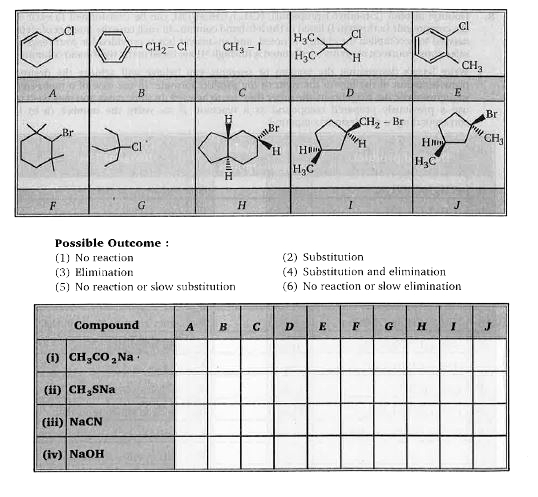
The correct Answer is:(##BLJMSCORGCHEJ∃C05CE02001_A01##)
Vinyl and aryl halide do not show substitution and elimination
Topper's Solved these Questions
- BOOK - MS CHOUHANCHAPTER - 5C ALKYL HALIDES EXERCISE - LEVEL-2 (SUBJECTIVE PROBLEMS)1videos
5C ALKYL HALIDES
- BOOK - MS CHOUHANCHAPTER - 5C ALKYL HALIDES EXERCISE - LEVEL-2 (SUBJECTIVE PROBLEMS)1videos
5C ALKYL HALIDES
- BOOK - MS CHOUHANCHAPTER - ALCOHOL,ETHERS AND EPOXIDESEXERCISE - SUBJECTIVE PROBLEMS1videos
ALCOHOL,ETHERS AND EPOXIDES
Similar Questions
the following oranic haide derivativs (A to J) are reaccted in ethanol solution with each of the nuleophiles : acetate , methytjhliate ,cyandie and hydroxide anioous Six possible reasult from these combination of reaction s reactants are desigented (1) through (^) below:
write the un=mber corresponding to your best estmte of the outcome of each reaction in the approride answer box below.
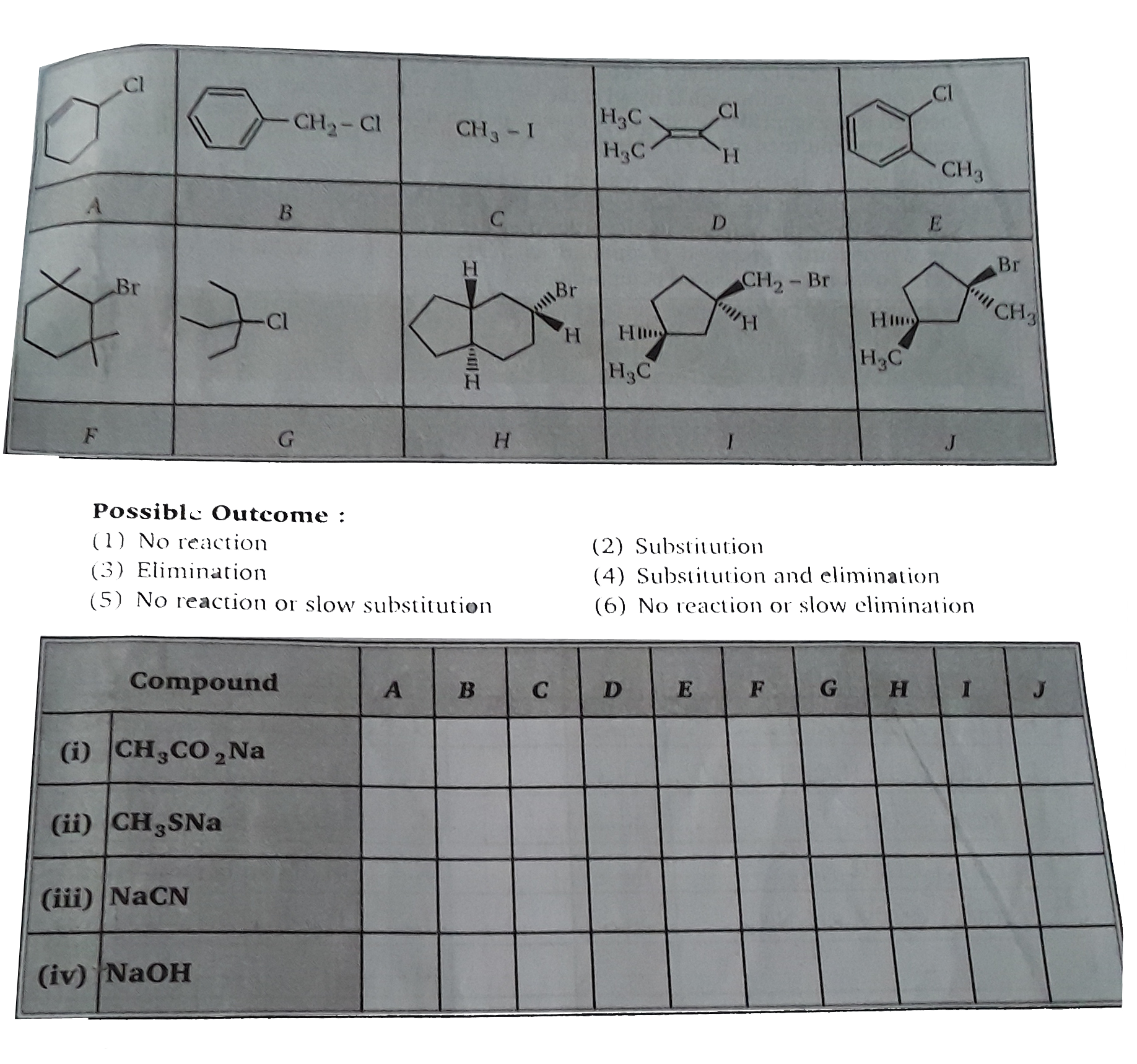 View Solution
View SolutionIsobuty alcohol (2 -mehyl 1 -1-propanol), (CH3)2CHCH2OH, can be transformed to each of the compounds (a through 1) listed in the left-hand column. In each case the number of steps the needed to accomplish the change is noted, and an answer box is noted, and answer box is provided for your reagent selections. Fourteen reagents (designated A through N) are listen in the right -hand column. corresponding to the desired compound.
Write letters desiganating the raagent or reagents you believe will achieve the desired transformation in the box to the right of the product formula. In the case of a multi-step sequence write the reagents in the order they are to be used. In some cases you may wish to use a previously prepared compound as a reactant. If so, write the number (a to 1) corresponding to the desired compound.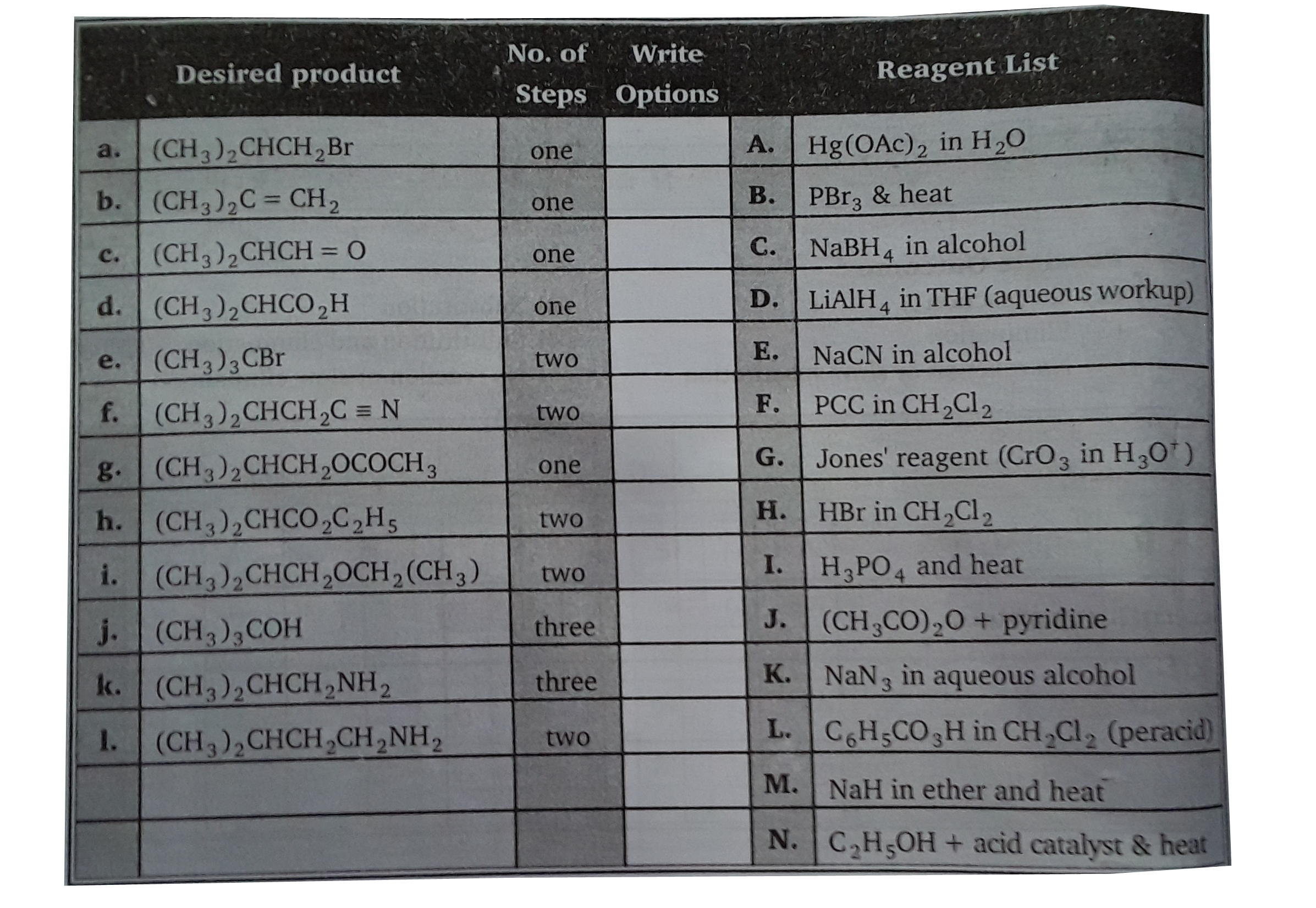 View Solution
View Solution
Knowledge Check
- Question 1 - Select One
Read the passage given below and answer the following questions:
Nucleophilic substitution reaction of haloalkane can be conducted according to both S1N and S2N mechanisms. However, which mechanism it is based on is related to such factors as the structure of haloalkane, and properties of leaving group, nucleophilic reagent and solvent.
Influences of halogen : No matter which mechanism the nucleophilic substitution reaction is based on, the leaving group always leave the central carbon atom with electron pair. This is just the opposite of the situation that nucleophilic reagent attacks the central carbon atom with electron pair. Therefore, the weaker the alkalinity of leaving group is , the more stable the anion formed is and it will be more easier for the leaving group to leave the central carbon atom, that is to say, the reactant is more easier to be substituted. The alkalinity order of halogen ion is I−<Br−<Cl−<F− and the order of their leaving tendency should be I−>Br−>Cl−>F− . Therefore, in four halides with the same alkyl and different halogens, the order of substitution reaction rate is RI>RBr>RCl>RF . In addition, if the leaving group is very easy to leave, many carbocation intermediates are generated in the reaction and the reaction is based on S1N mechanism. If the leaving group is not easy to leave, the reaction is based on S2N mechanism.
Influences of solvent polarity: In S1N reaction, the polarity of the system increases from the reactant to the transition state, because polar solvent has a greater stabilizing effect on the transition state than the reactant, thereby reduce activation energy and accelerate the reaction. In S2N reaction, the polarity of the system generally does not change from the reactant to the transition state and only charge dispersion occurs. At this time, polar solvent has a great stabilizing effect on Nu than the transition state, thereby increasing activation energy and slow down the reaction rate. For example, the decomposition rate (S1N) of tertiary chlorobutane in 25∘C water (dielectric constant 79) is 300000 times faster than in ethanol (dielectric constant 24). The reaction rate (S2N) of 2-bromopropane and NaOH in ethanol containing 40% water is twice slower than in absolute ethanol. In a word, the level of solvent polarity has influence on both S1N and S2N reactions, but with different results. Generally speaking, weak polar solvent is favorable for S2N reaction, while strong polar solvent is favorable for S1N reaction, because only under the action of polar solvent can halogenated hydrocarbon dissociate into carbocation and halogen ion and solvents with a strong polarity is favorable for solvation of carbocation, increasing its stability. Generally speaking, the substitution reaction of tertiary haloalkane is based on S1N mechanism in solvents with a strong polarity (for example, ethanol containing water).
(Ding, Y. (2013). A Brief Discussion on Nucleophilic Substitution Reaction on Saturated Carbon Atom. In Applied Mechanics and Materials (Vol. 312, pp. 433-437). Trans Tech Publications Ltd.)
Nucleophilic substitution will be fastest in case of:A1-Chloro-2,2-dimethyl propaneB1-Iodo-2,2-dimethyl propaneC1-Bromo-2,2-dimethyl propaneD1-Fluoro-2,2-dimethyl propane - Question 2 - Select One
Read the passage given below and answer the following questions:
Nucleophilic substitution reaction of haloalkane can be conducted according to both S1N and S2N mechanisms. However, which mechanism it is based on is related to such factors as the structure of haloalkane, and properties of leaving group, nucleophilic reagent and solvent.
Influences of halogen : No matter which mechanism the nucleophilic substitution reaction is based on, the leaving group always leave the central carbon atom with electron pair. This is just the opposite of the situation that nucleophilic reagent attacks the central carbon atom with electron pair. Therefore, the weaker the alkalinity of leaving group is , the more stable the anion formed is and it will be more easier for the leaving group to leave the central carbon atom, that is to say, the reactant is more easier to be substituted. The alkalinity order of halogen ion is I−<Br−<Cl−<F− and the order of their leaving tendency should be I−>Br−>Cl−>F− . Therefore, in four halides with the same alkyl and different halogens, the order of substitution reaction rate is RI>RBr>RCl>RF . In addition, if the leaving group is very easy to leave, many carbocation intermediates are generated in the reaction and the reaction is based on S1N mechanism. If the leaving group is not easy to leave, the reaction is based on S2N mechanism.
Influences of solvent polarity: In S1N reaction, the polarity of the system increases from the reactant to the transition state, because polar solvent has a greater stabilizing effect on the transition state than the reactant, thereby reduce activation energy and accelerate the reaction. In S2N reaction, the polarity of the system generally does not change from the reactant to the transition state and only charge dispersion occurs. At this time, polar solvent has a great stabilizing effect on Nu than the transition state, thereby increasing activation energy and slow down the reaction rate. For example, the decomposition rate (S1N) of tertiary chlorobutane in 25∘C water (dielectric constant 79) is 300000 times faster than in ethanol (dielectric constant 24). The reaction rate (S2N) of 2-bromopropane and NaOH in ethanol containing 40% water is twice slower than in absolute ethanol. In a word, the level of solvent polarity has influence on both S1N and S2N reactions, but with different results. Generally speaking, weak polar solvent is favorable for S2N reaction, while strong polar solvent is favorable for S1N reaction, because only under the action of polar solvent can halogenated hydrocarbon dissociate into carbocation and halogen ion and solvents with a strong polarity is favorable for solvation of carbocation, increasing its stability. Generally speaking, the substitution reaction of tertiary haloalkane is based on S1N mechanism in solvents with a strong polarity (for example, ethanol containing water).
(Ding, Y. (2013). A Brief Discussion on Nucleophilic Substitution Reaction on Saturated Carbon Atom. In Applied Mechanics and Materials (Vol. 312, pp. 433-437). Trans Tech Publications Ltd.)
S1N mechanism is favoured in which of the following solvents:AbenzeneBcarbon tetrachlorideCacetic acidDcarbon disulphide - Question 3 - Select One
Read the passage given below and answer the following questions:
Nucleophilic substitution reaction of haloalkane can be conducted according to both S1N and S2N mechanisms. However, which mechanism it is based on is related to such factors as the structure of haloalkane, and properties of leaving group, nucleophilic reagent and solvent.
Influences of halogen : No matter which mechanism the nucleophilic substitution reaction is based on, the leaving group always leave the central carbon atom with electron pair. This is just the opposite of the situation that nucleophilic reagent attacks the central carbon atom with electron pair. Therefore, the weaker the alkalinity of leaving group is , the more stable the anion formed is and it will be more easier for the leaving group to leave the central carbon atom, that is to say, the reactant is more easier to be substituted. The alkalinity order of halogen ion is I−<Br−<Cl−<F− and the order of their leaving tendency should be I−>Br−>Cl−>F− . Therefore, in four halides with the same alkyl and different halogens, the order of substitution reaction rate is RI>RBr>RCl>RF . In addition, if the leaving group is very easy to leave, many carbocation intermediates are generated in the reaction and the reaction is based on S1N mechanism. If the leaving group is not easy to leave, the reaction is based on S2N mechanism.
Influences of solvent polarity: In S1N reaction, the polarity of the system increases from the reactant to the transition state, because polar solvent has a greater stabilizing effect on the transition state than the reactant, thereby reduce activation energy and accelerate the reaction. In S2N reaction, the polarity of the system generally does not change from the reactant to the transition state and only charge dispersion occurs. At this time, polar solvent has a great stabilizing effect on Nu than the transition state, thereby increasing activation energy and slow down the reaction rate. For example, the decomposition rate (S1N) of tertiary chlorobutane in 25∘C water (dielectric constant 79) is 300000 times faster than in ethanol (dielectric constant 24). The reaction rate (S2N) of 2-bromopropane and NaOH in ethanol containing 40% water is twice slower than in absolute ethanol. In a word, the level of solvent polarity has influence on both S1N and S2N reactions, but with different results. Generally speaking, weak polar solvent is favorable for S2N reaction, while strong polar solvent is favorable for S1N reaction, because only under the action of polar solvent can halogenated hydrocarbon dissociate into carbocation and halogen ion and solvents with a strong polarity is favorable for solvation of carbocation, increasing its stability. Generally speaking, the substitution reaction of tertiary haloalkane is based on S1N mechanism in solvents with a strong polarity (for example, ethanol containing water).
(Ding, Y. (2013). A Brief Discussion on Nucleophilic Substitution Reaction on Saturated Carbon Atom. In Applied Mechanics and Materials (Vol. 312, pp. 433-437). Trans Tech Publications Ltd.)
S1N reaction will be fastest in case of:A1-Chloro-2-methyl propaneB1-Iodo-2-methyl propaneC1-ChlorobutaneD1-Iodobutane
Ecamine structures a through j, shown below, with reaspect to their symmerty or lack of it. Assuming that the five-membered rings and the ring in compound g are plannr. The wedgephatched bonds in b,c,d & e designate specific configuration. Also for the acyclic compounds assume stable anti conformations. Answer each of the following questions by writing letters (a through j), corresponding to your selections, in each answer box. If there is no structure that fits the description enter an x in the answer box.
 View Solution
View SolutionThis problem is an introduction to the planning of multistep syntheses.
For use, you have six reactant compound (A through F), and eight reagents (1 through 8), shown below.
Following these lists, five multistep syntheses are outlined. For each of these, certain reactants or reagents must be identified by writing an appropriate letter or number in designated answer boxes. Write a single letter or number, indicating your choice of the best reactant, in each answer box.

(1) Jones' reagent [Na2Cr2O7 in H3O+], (2) PCC[CrO3 in pyridine +HCl]
(3) Sodium hydride NaH, (4) Sodium borohydride NaBH4
(5) Thionyl chloride SOCl2, (6) Phosphorus tribromide PBr3
(7) Aluminium trichloride AlCl3, (8) Magnesium turnings in ether
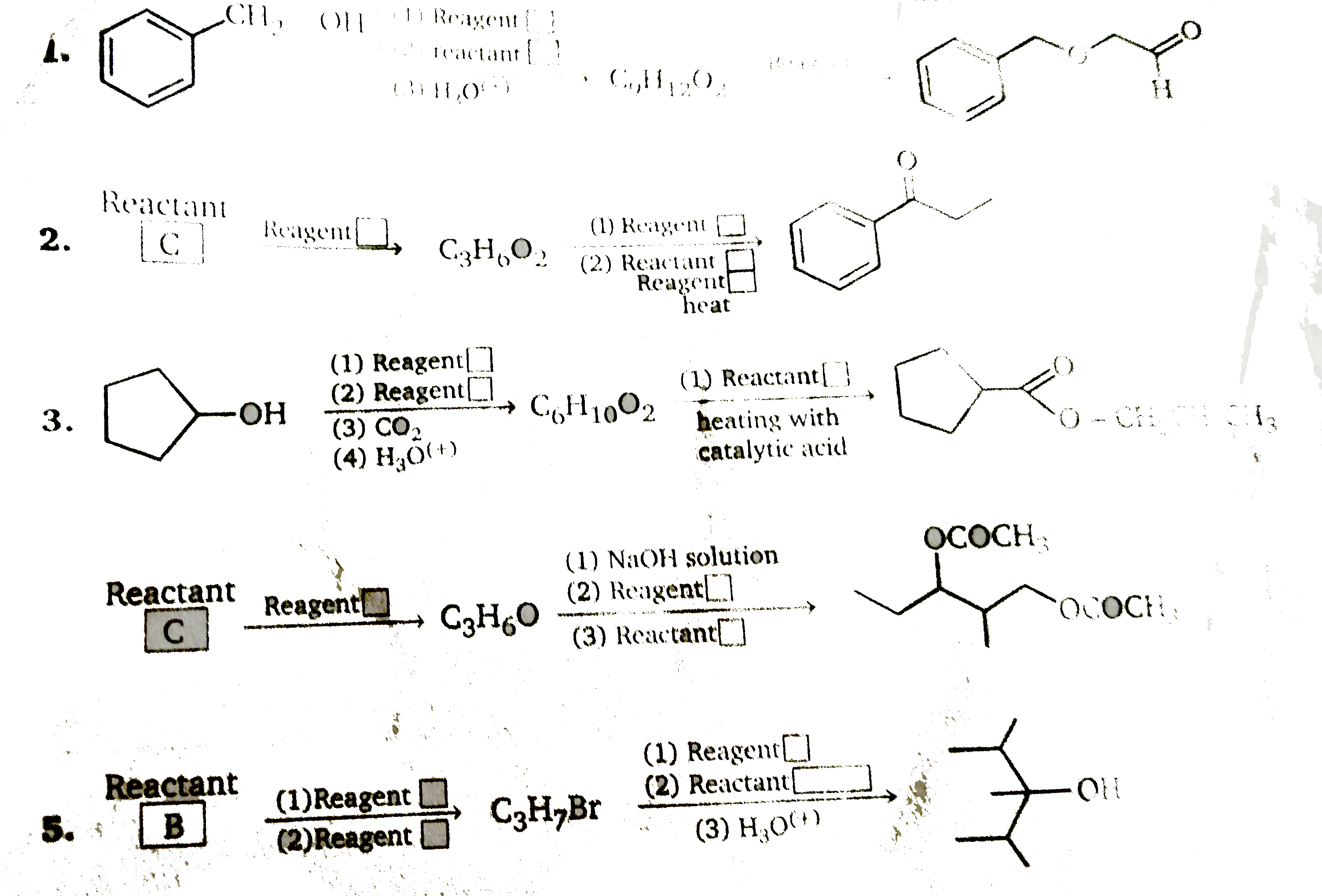 View Solution
View SolutionIsobutyl alcohol (2-methyl-1-propanol) (CH3)2CHCH2OH, can be transformed to each of the compounds (a through 1) listed in the left-hand column. In each case the number of steps needed to accomplish the change is noted, and an answer box is provided for your reagent Write letters designating the reagent or reagents you believe will achieve the desired transformation in the box to the right of the product formula. In the case of a multi-step sequence write the reagents in the order they are to be used. In some cases you maywish to use a previously prepared compound as a reactant. If so, write the number (a to 1) corresponding to the desired compound.
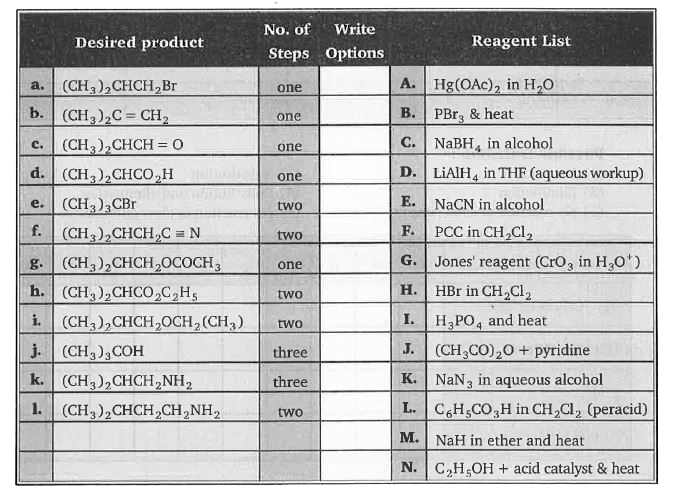 View Solution
View SolutionThis problem is an introduction to the planning of multistep syntheses
For use, you have six reactant compounds (A through F) , and eight reagents (1 through 8), shown below
Following these lists, five multistep syntheses are outlined. For each of these, certain reactants or reagents must be identified by writing an appropriate letter or number in designated answer boxes. Write a single letter or number, indicating your choice ofthe best reactant or reagent, in each answer box.
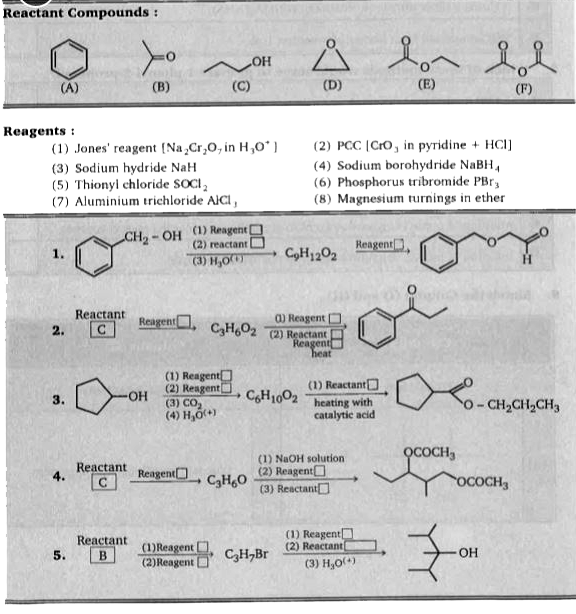 View Solution
View SolutionConsider the pairs of ethers, numbered I through V, shown below. To the right of each pair is a description of reaction conditions to be applied to each. One compound of the pair will react more rapidily than the other.
Which ether of the two be more rapidily cleaved?
write your answer in box.
 View Solution
View Solution

